|
NESTOS
DELTA
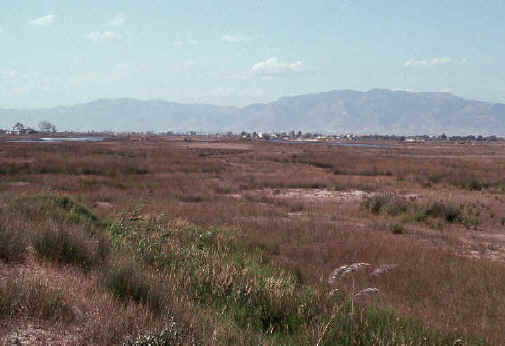 Any
naturalist staying on Thásos should take the opportunity of taking the ferry to
Keramoti and visiting the outstanding habitats of the Nestos Delta on the
adjacent mainland. The Nestos
River begins on Mt. Rila in Bulgaria and travels 234kms through the Rhodope Mountains
to reach
the Aegean sea east of Keramoti. Within Greece, the 140kms, from the Central
Rodopi Forests on the Bulgarian border, down through the Nestos Gorge to the
vast expanse of lakes and marshes of the Delta, are of exceptional importance for
wildlife. Most of the area is a proposed National Park, containing three
separate Special Protection Areas for bird conservation, and the 125,000 acres
of the Delta are designated as a
Ramsar Wetland site. Any
naturalist staying on Thásos should take the opportunity of taking the ferry to
Keramoti and visiting the outstanding habitats of the Nestos Delta on the
adjacent mainland. The Nestos
River begins on Mt. Rila in Bulgaria and travels 234kms through the Rhodope Mountains
to reach
the Aegean sea east of Keramoti. Within Greece, the 140kms, from the Central
Rodopi Forests on the Bulgarian border, down through the Nestos Gorge to the
vast expanse of lakes and marshes of the Delta, are of exceptional importance for
wildlife. Most of the area is a proposed National Park, containing three
separate Special Protection Areas for bird conservation, and the 125,000 acres
of the Delta are designated as a
Ramsar Wetland site.
The
Delta itself consists of a mosaic of sand dunes, brackish lagoons and saltmarsh,
with Kotza Orman Forest the largest expanse of riparian woodland (dominated by poplar Populus, willow
Salix and plane Platanus) in the southern Balkans. The sand dunes extend for 50kms
eastwards from Keramoti and are the largest example of this habitat in north-eastern Greece. They
are
largely undisturbed, low marram Ammophila arenaria dunes
"dominated by an endemic plant association of Ephedra with Cyperus capitatus, sea daffodil Pancratium and sea holly Eryngium maritimum. At least at the Keramoti
end this is a rather narrow zone, about 300 metres wide, but further east the dunes
are reported to extend up to 1.5 kilometres inland. Dune tiger beetles Cicindela
lunulata are abundant in the foredunes and the spur-thighed tortoise Testudo
graeca is frequently seen. This is a very important habitat for
the conservation of sand dune plants and animals in Greece and hopefully the encroaching
development from Keramoti will have minimal impact on the fauna.
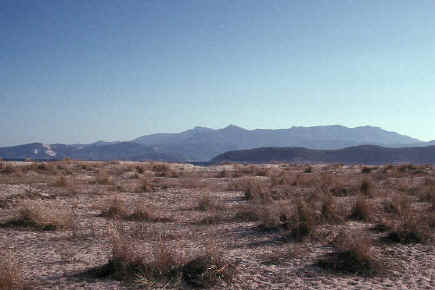 Behind
the dunes are the extensive flats of saltpans, saltmarsh and sandy grassland,
interspersed with brackish lagoons, Arundo donax reedbeds, tamarisk scrub
and river channels. This is an exceptional area for birdlife and supports the
most important population
of spur-winged plovers Holopterus spinosus in
Europe. Other breeding bird species include little bittern Ixobrychus minutus,
night heron Nycticorax nycticorax, little egret Egretta
garzetta, purple heron Ardea purpurea, white stork Ciconia ,
ruddy shelduck Tadorna ferruginea, marsh harrier Circus aeruginosus, Levant
sparrowhawk Accipiter
brevipes, lesser spotted eagle Aquila pomarina, black-winged stilt Himantopus himantopus,
avocet Recurvirostra
avosetta, stone curlew Burhinus oedicnemus, collared pratincole Glareola pratincola,
little tern Sterna , roller Coracias
garrulus, Calandra lark Melanocrypha calandra, rufous bush robin Cercotrichas galactotes,
lesser grey shrike Lanius
minor, and masked shrike Lanius nubicus. Wintering species
include pygmy cormorant Phalacrocorax pygmeus, Dalmatian Pelican Pelecanus
crispus, great white egret Egretta alba, white-tailed eagle Haliaeetus albicilla and
spotted Eagle Aquila
clanga (for further information on birdwatching in this area see http://www.eurobirding.co.uk/nestos_delta.htm
and the splendid book by Steve Mills
Birdwatching in Northern Greece) Behind
the dunes are the extensive flats of saltpans, saltmarsh and sandy grassland,
interspersed with brackish lagoons, Arundo donax reedbeds, tamarisk scrub
and river channels. This is an exceptional area for birdlife and supports the
most important population
of spur-winged plovers Holopterus spinosus in
Europe. Other breeding bird species include little bittern Ixobrychus minutus,
night heron Nycticorax nycticorax, little egret Egretta
garzetta, purple heron Ardea purpurea, white stork Ciconia ,
ruddy shelduck Tadorna ferruginea, marsh harrier Circus aeruginosus, Levant
sparrowhawk Accipiter
brevipes, lesser spotted eagle Aquila pomarina, black-winged stilt Himantopus himantopus,
avocet Recurvirostra
avosetta, stone curlew Burhinus oedicnemus, collared pratincole Glareola pratincola,
little tern Sterna , roller Coracias
garrulus, Calandra lark Melanocrypha calandra, rufous bush robin Cercotrichas galactotes,
lesser grey shrike Lanius
minor, and masked shrike Lanius nubicus. Wintering species
include pygmy cormorant Phalacrocorax pygmeus, Dalmatian Pelican Pelecanus
crispus, great white egret Egretta alba, white-tailed eagle Haliaeetus albicilla and
spotted Eagle Aquila
clanga (for further information on birdwatching in this area see http://www.eurobirding.co.uk/nestos_delta.htm
and the splendid book by Steve Mills
Birdwatching in Northern Greece)
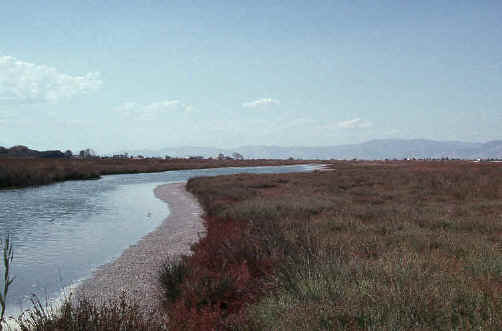 The yellow jackal Canis aureus occurs here at one of its few
sites in Europe and the European souslik Spermophilus cetellus and the
wild cat Felis silvestris are also reported from the Delta, which
supports the largest otter Lutra lutra population in Greece. Important
assemblages of fish (17 species), reptiles and amphibians (22 species) have been recorded. The Delta as a
whole, including the freshwater lakes of Aladjagola at Chryssoupolis, supports
thirty-one dragonfly species and fifty-seven butterfly species, with populations
of Alcon blue
Maculinea alcon, large copper The yellow jackal Canis aureus occurs here at one of its few
sites in Europe and the European souslik Spermophilus cetellus and the
wild cat Felis silvestris are also reported from the Delta, which
supports the largest otter Lutra lutra population in Greece. Important
assemblages of fish (17 species), reptiles and amphibians (22 species) have been recorded. The Delta as a
whole, including the freshwater lakes of Aladjagola at Chryssoupolis, supports
thirty-one dragonfly species and fifty-seven butterfly species, with populations
of Alcon blue
Maculinea alcon, large copper
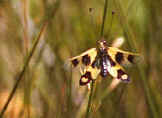 Lycaena dispar and the dragonfly Omphogomphus
cecilia. In June the ascalaphid Libelloides macaronius (Neuroptera, Ascalaphidae) can be seen hunting over the sandy grasslands.
Five species of these predatory
insects, something of a cross between ant-lions and dragonflies, have been
recorded from Greece and Popov (Popov, A. 2004. The Ascalaphidae (Neuroptera)
of the Balkan Peninsula. Denisia, 13: 229-237.) maps two species (Deleproctophylla
australis and Libelloides lacteus) as
having been reported from Thásos. Lycaena dispar and the dragonfly Omphogomphus
cecilia. In June the ascalaphid Libelloides macaronius (Neuroptera, Ascalaphidae) can be seen hunting over the sandy grasslands.
Five species of these predatory
insects, something of a cross between ant-lions and dragonflies, have been
recorded from Greece and Popov (Popov, A. 2004. The Ascalaphidae (Neuroptera)
of the Balkan Peninsula. Denisia, 13: 229-237.) maps two species (Deleproctophylla
australis and Libelloides lacteus) as
having been reported from Thásos.
The whole area has
been under tremendous pressure from unregulated development but since 1996, when
the Greek government finally determined the boundaries of the Ramsar site, much
has been done to establish a suitable management plan and to work with adjoining
communities to reduce harmful impacts and to conserve the biological richness of
the Delta. The inclusion of Nestos in the EU LIFE 'Living
Lakes' project has given further impetus to the conservation efforts.
The
Nestos Riparian Forest Visitor Centre is run by the
Forestry Service of Kavala Prefecture. This is about 2kms out of Keramoti on the
road to Chryssoupolis. The turning is signposted on the right - follow a rough track for 4.5
kms through farmland, continuing straight on and ignoring any turnings. Phone in
advance if possible (Tel.:
2510-247042 / 2510-461803)
to
check that they will be open.
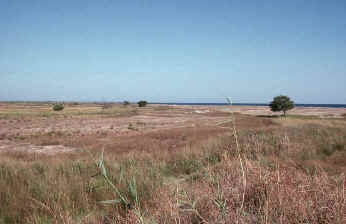 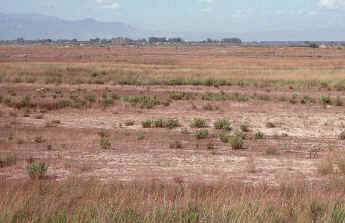  
|

 Any
naturalist staying on Thásos should take the opportunity of taking the ferry to
Keramoti and visiting the outstanding habitats of the Nestos Delta on the
adjacent mainland. The Nestos
River begins on Mt. Rila in Bulgaria and travels 234kms through the Rhodope Mountains
to reach
the Aegean sea east of Keramoti. Within Greece, the 140kms, from the Central
Rodopi Forests on the Bulgarian border, down through the Nestos Gorge to the
vast expanse of lakes and marshes of the Delta, are of exceptional importance for
wildlife. Most of the area is a proposed National Park, containing three
separate Special Protection Areas for bird conservation, and the 125,000 acres
of the Delta are designated as a
Any
naturalist staying on Thásos should take the opportunity of taking the ferry to
Keramoti and visiting the outstanding habitats of the Nestos Delta on the
adjacent mainland. The Nestos
River begins on Mt. Rila in Bulgaria and travels 234kms through the Rhodope Mountains
to reach
the Aegean sea east of Keramoti. Within Greece, the 140kms, from the Central
Rodopi Forests on the Bulgarian border, down through the Nestos Gorge to the
vast expanse of lakes and marshes of the Delta, are of exceptional importance for
wildlife. Most of the area is a proposed National Park, containing three
separate Special Protection Areas for bird conservation, and the 125,000 acres
of the Delta are designated as a
 Behind
the dunes are the extensive flats of saltpans, saltmarsh and sandy grassland,
interspersed with brackish lagoons, Arundo donax reedbeds, tamarisk scrub
and river channels. This is an exceptional area for birdlife and supports the
most important population
of spur-winged plovers Holopterus spinosus in
Europe. Other breeding bird species include little bittern Ixobrychus minutus,
night heron Nycticorax nycticorax, little egret Egretta
garzetta, purple heron Ardea purpurea, white stork Ciconia ,
ruddy shelduck Tadorna ferruginea, marsh harrier Circus aeruginosus, Levant
sparrowhawk Accipiter
brevipes, lesser spotted eagle Aquila pomarina, black-winged stilt Himantopus himantopus,
avocet Recurvirostra
avosetta, stone curlew Burhinus oedicnemus, collared pratincole Glareola pratincola,
little tern Sterna , roller Coracias
garrulus, Calandra lark Melanocrypha calandra, rufous bush robin Cercotrichas galactotes,
lesser grey shrike Lanius
minor, and masked shrike Lanius nubicus. Wintering species
include pygmy cormorant Phalacrocorax pygmeus, Dalmatian Pelican Pelecanus
crispus, great white egret Egretta alba, white-tailed eagle Haliaeetus albicilla and
spotted Eagle Aquila
clanga (for further information on birdwatching in this area see
Behind
the dunes are the extensive flats of saltpans, saltmarsh and sandy grassland,
interspersed with brackish lagoons, Arundo donax reedbeds, tamarisk scrub
and river channels. This is an exceptional area for birdlife and supports the
most important population
of spur-winged plovers Holopterus spinosus in
Europe. Other breeding bird species include little bittern Ixobrychus minutus,
night heron Nycticorax nycticorax, little egret Egretta
garzetta, purple heron Ardea purpurea, white stork Ciconia ,
ruddy shelduck Tadorna ferruginea, marsh harrier Circus aeruginosus, Levant
sparrowhawk Accipiter
brevipes, lesser spotted eagle Aquila pomarina, black-winged stilt Himantopus himantopus,
avocet Recurvirostra
avosetta, stone curlew Burhinus oedicnemus, collared pratincole Glareola pratincola,
little tern Sterna , roller Coracias
garrulus, Calandra lark Melanocrypha calandra, rufous bush robin Cercotrichas galactotes,
lesser grey shrike Lanius
minor, and masked shrike Lanius nubicus. Wintering species
include pygmy cormorant Phalacrocorax pygmeus, Dalmatian Pelican Pelecanus
crispus, great white egret Egretta alba, white-tailed eagle Haliaeetus albicilla and
spotted Eagle Aquila
clanga (for further information on birdwatching in this area see  The yellow jackal Canis aureus occurs here at one of its few
sites in Europe and the European souslik Spermophilus cetellus and the
wild cat Felis silvestris are also reported from the Delta, which
supports the largest otter Lutra lutra population in Greece. Important
assemblages of fish (17 species), reptiles and amphibians (22 species) have been recorded. The Delta as a
whole, including the freshwater lakes of Aladjagola at Chryssoupolis, supports
thirty-one dragonfly species and fifty-seven butterfly species, with populations
of Alcon blue
Maculinea alcon, large copper
The yellow jackal Canis aureus occurs here at one of its few
sites in Europe and the European souslik Spermophilus cetellus and the
wild cat Felis silvestris are also reported from the Delta, which
supports the largest otter Lutra lutra population in Greece. Important
assemblages of fish (17 species), reptiles and amphibians (22 species) have been recorded. The Delta as a
whole, including the freshwater lakes of Aladjagola at Chryssoupolis, supports
thirty-one dragonfly species and fifty-seven butterfly species, with populations
of Alcon blue
Maculinea alcon, large copper
 Lycaena dispar and the dragonfly Omphogomphus
cecilia. In June the ascalaphid Libelloides macaronius (Neuroptera, Ascalaphidae) can be seen hunting over the sandy grasslands.
Five species of these predatory
insects, something of a cross between ant-lions and dragonflies, have been
recorded from Greece and Popov (Popov, A. 2004. The Ascalaphidae (Neuroptera)
of the Balkan Peninsula. Denisia, 13: 229-237.) maps two species (Deleproctophylla
australis and Libelloides lacteus) as
having been reported from Thásos.
Lycaena dispar and the dragonfly Omphogomphus
cecilia. In June the ascalaphid Libelloides macaronius (Neuroptera, Ascalaphidae) can be seen hunting over the sandy grasslands.
Five species of these predatory
insects, something of a cross between ant-lions and dragonflies, have been
recorded from Greece and Popov (Popov, A. 2004. The Ascalaphidae (Neuroptera)
of the Balkan Peninsula. Denisia, 13: 229-237.) maps two species (Deleproctophylla
australis and Libelloides lacteus) as
having been reported from Thásos.


